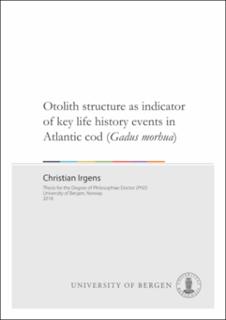| dc.contributor.author | Irgens, Christian | |
| dc.date.accessioned | 2018-11-12T09:20:09Z | |
| dc.date.available | 2018-11-12T09:20:09Z | |
| dc.date.issued | 2018-08-27 | |
| dc.identifier.uri | https://hdl.handle.net/1956/18712 | |
| dc.description.abstract | Otoliths are remarkable recorders of the individual life history, as they can reflect the growth trajectory and may encapsulate marks related to ontogenetic, physiological and environmental events. Visible and chemical information from otoliths may provide novel insights related to encountered environmental conditions that are difficult, if not impossible, to achieve by other means. However, a prerequisite to accurately elucidate the background of each individual from interpretations of otolith characteristics, is to understand how ultimate-proximate factors influence the otolith formation process as such. Although the biomineralization process of otoliths is indeed linked to physiology and in particular to metabolic expression, both environmental conditions and ontogeny may affect otolith formation. There are still unresolved issues concerning the precise relationship between intrinsic and extrinsic factors, which may have confounding effects when aiming at fundamentally understanding the process of otolith formation. Hence, this may introduce uncertainties to the interpretation of otoliths in terms of the expressed growth rate, opacity pattern, otolith shape and morphology. This also highlights the importance of validation studies on commercial fish species where otolith characteristics are used to determine age and key life history events that may be essential to stock assessment and management. This thesis thus aimed to resolve how two main life history events, i.e. juvenile settlement and initiation of sexual maturation, can impact the otoliths of Atlantic cod (Gadus morhua), combining both field data and experimental studies. I have further evaluated how underlying endogenous and exogenous factors may fluctuate during life history events, and to what extent this may influence otolith growth and shape. Based on extensive sampling of juvenile cod during trawl surveys in the Barents Sea, settlement was found to have a significant effect on the otolith external morphology. Increased formation of lobe structures was evident during the pelagic stage. However, this process was markedly abrupted during settlement in the autumn. Further investigations of the effects related to environmental conditions revealed that summer temperatures in the Barents Sea were linked to otolith lobe formation. No differences were found in otolith shape between sympatric juvenile Barents Sea (BS) and Norwegian coastal (NC) cod, suggesting that otolith shape is mainly defined environmentally rather than by differences in population genetics. Furthermore, the production and release of gametes has previously been suggested to induce a transition in the otolith zone structure and the formation of so-called spawning zones which are frequently observed in adult BS and NC cod. This otolith characteristic is therefore operationally used in assessments of spawning stock biomass, i.e. to numerically separate sexually immatures and matures, although no previous studies have rigorously validated these structures. Thus, to elucidate this mechanism, we demonstrate experimentally how energy investment related to sexual maturation and spawning may affect otolith growth and zone formation. The impacts on otolith structure were only significant in individuals with high reproductive investments, while otoliths from those with low investments (e.g. in first-time spawners) did not differ from immatures. This suggests that the individual energy level, as a premise for metabolic activity, plays an important role in the formation of spawning zones, and thus largely depends on experienced environmental conditions. Low investment in reproduction may thus not necessarily induce spawning zones, or stated differently, presence or absence of presumed spawning zones may not necessarily always reflect the real reproductive history of an individual. Altogether, this doctoral thesis demonstrates that important life history events affect otolith formation in cod. More specifically, this work exemplifies how otolith shape ontogeny in juvenile cod from the Barents Sea markedly changes during the settlement event. Importantly, this thesis also demonstrate that environmental factors influence the shape formation during early life, indicating a plasticity in the ontogenetically driven shape formation. Finally, it was shown that the act of reproduction not necessarily induce spawning zones and thereby telling that this characteristic might occasionally be a misnomer. Thus, the in-depth analyses and findings given in this thesis should contribute valuably to on-going efforts to increase the quality of otolith readings as a central part in fish stock assessments and management routines. | en_US |
| dc.language.iso | eng | eng |
| dc.publisher | The University of Bergen | en_US |
| dc.relation.haspart | Paper I: Irgens, C., Kjesbu, O.S. and Folkvord, A. (2017) Ontogenetic development of otolith shape during settlement of juvenile Barents Sea cod (Gadus morhua). ICES Journal of Marine Science 74: 2389-2397. Full text not available in BORA due to publisher restrictions. The article is available at: <a href="https://doi.org/10.1093/icesjms/fsx088" target="blank">https://doi.org/10.1093/icesjms/fsx088</a> | en_US |
| dc.relation.haspart | Paper II: Irgens, C., Kjesbu, O.S., Johansen, T., and Folkvord, A.. Spatiotemporal differences in otolith shape in juvenile cod coupled to temperature variations in the Barents Sea. Full text not available in BORA. | en_US |
| dc.relation.haspart | Paper III: Irgens, C., Folkvord, A., Otterå, H., and Kjesbu, O.S.. Otolith growth and zone formation during first maturity and spawning of Atlantic cod (Gadus morhua). Full text not available in BORA. | en_US |
| dc.title | Otolith structure as indicator of key life history events in Atlantic cod (Gadus morhua) | en_US |
| dc.title.alternative | Otolith structure as indicator of key life history events in Atlantic cod (Gadus morhua) | eng |
| dc.type | Doctoral thesis | |
| dc.rights.holder | Copyright the Author. All rights reserved | en_US |
| dc.identifier.cristin | 1603456 | |
